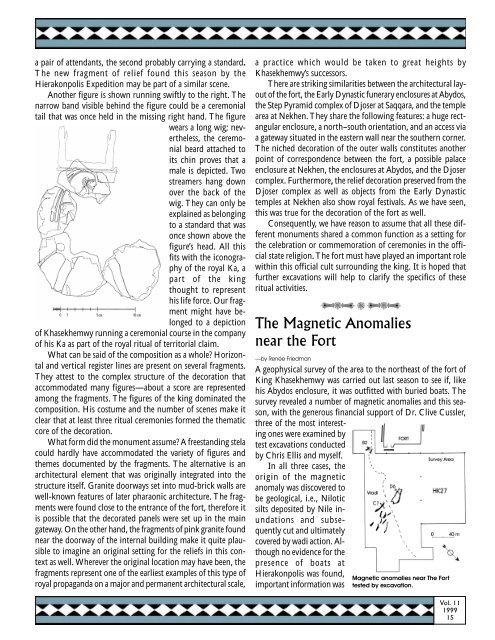Nekhen News 11 - Hierakonpolis Online
Nekhen News 11 - Hierakonpolis Online
Nekhen News 11 - Hierakonpolis Online
You also want an ePaper? Increase the reach of your titles
YUMPU automatically turns print PDFs into web optimized ePapers that Google loves.
a pair of attendants, the second probably carrying a standard.<br />
The new fragment of relief found this season by the<br />
<strong>Hierakonpolis</strong> Expedition may be part of a similar scene.<br />
Another figure is shown running swiftly to the right. The<br />
narrow band visible behind the figure could be a ceremonial<br />
tail that was once held in the missing right hand. The figure<br />
wears a long wig; nevertheless,<br />
the ceremonial<br />
beard attached to<br />
its chin proves that a<br />
male is depicted. Two<br />
streamers hang down<br />
over the back of the<br />
wig. They can only be<br />
explained as belonging<br />
to a standard that was<br />
once shown above the<br />
figure’s head. All this<br />
fits with the iconography<br />
of the royal Ka, a<br />
part of the king<br />
thought to represent<br />
his life force. Our fragment<br />
might have belonged<br />
to a depiction<br />
of Khasekhemwy running a ceremonial course in the company<br />
of his Ka as part of the royal ritual of territorial claim.<br />
What can be said of the composition as a whole? Horizontal<br />
and vertical register lines are present on several fragments.<br />
They attest to the complex structure of the decoration that<br />
accommodated many figures—about a score are represented<br />
among the fragments. The figures of the king dominated the<br />
composition. His costume and the number of scenes make it<br />
clear that at least three ritual ceremonies formed the thematic<br />
core of the decoration.<br />
What form did the monument assume? A freestanding stela<br />
could hardly have accommodated the variety of figures and<br />
themes documented by the fragments. The alternative is an<br />
architectural element that was originally integrated into the<br />
structure itself. Granite doorways set into mud-brick walls are<br />
well-known features of later pharaonic architecture. The fragments<br />
were found close to the entrance of the fort, therefore it<br />
is possible that the decorated panels were set up in the main<br />
gateway. On the other hand, the fragments of pink granite found<br />
near the doorway of the internal building make it quite plausible<br />
to imagine an original setting for the reliefs in this context<br />
as well. Wherever the original location may have been, the<br />
fragments represent one of the earliest examples of this type of<br />
royal propaganda on a major and permanent architectural scale,<br />
a practice which would be taken to great heights by<br />
Khasekhemwy’s successors.<br />
There are striking similarities between the architectural layout<br />
of the fort, the Early Dynastic funerary enclosures at Abydos,<br />
the Step Pyramid complex of Djoser at Saqqara, and the temple<br />
area at <strong>Nekhen</strong>. They share the following features: a huge rectangular<br />
enclosure, a north–south orientation, and an access via<br />
a gateway situated in the eastern wall near the southern corner.<br />
The niched decoration of the outer walls constitutes another<br />
point of correspondence between the fort, a possible palace<br />
enclosure at <strong>Nekhen</strong>, the enclosures at Abydos, and the Djoser<br />
complex. Furthermore, the relief decoration preserved from the<br />
Djoser complex as well as objects from the Early Dynastic<br />
temples at <strong>Nekhen</strong> also show royal festivals. As we have seen,<br />
this was true for the decoration of the fort as well.<br />
Consequently, we have reason to assume that all these different<br />
monuments shared a common function as a setting for<br />
the celebration or commemoration of ceremonies in the official<br />
state religion. The fort must have played an important role<br />
within this official cult surrounding the king. It is hoped that<br />
further excavations will help to clarify the specifics of these<br />
ritual activities.<br />
The Magnetic Anomalies<br />
near the Fort<br />
—by Renée Friedman<br />
A geophysical survey of the area to the northeast of the fort of<br />
King Khasekhemwy was carried out last season to see if, like<br />
his Abydos enclosure, it was outfitted with buried boats. The<br />
survey revealed a number of magnetic anomalies and this season,<br />
with the generous financial support of Dr. Clive Cussler,<br />
three of the most interesting<br />
ones were examined by<br />
test excavations conducted<br />
by Chris Ellis and myself.<br />
In all three cases, the<br />
origin of the magnetic<br />
anomaly was discovered to<br />
be geological, i.e., Nilotic<br />
silts deposited by Nile inundations<br />
and subsequently<br />
cut and ultimately<br />
covered by wadi action. Although<br />
no evidence for the<br />
presence of boats at<br />
<strong>Hierakonpolis</strong> was found,<br />
important information was<br />
Magnetic anomalies near The Fort<br />
tested by excavation.<br />
Vol. <strong>11</strong><br />
1999<br />
15


